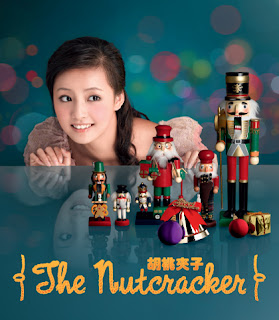 |
| My collection of nutcrackers |
During Christmas, Santas Claus, Christmas trees, bells and the three wise men begin to appear on the streets and we all know where they originate from. How about nutcrackers? Where do they come from? That's the question.
The historical origin of nutcracker is quite murky. Before the present - day soldiers and kings, nutcrackers has existed in many forms and many have indeed been beautifully crafted into wooden sculpture. It is said that one times in a German village, a group of soliders have done grave injustice but unable to do anything more, the villagers crafted soldiers as nutcrackers to ridicule them.
In another source, the Dictionary of Brother Grim (authors of Grim Fairy Tales), described nutcrackers as 'a misshaped little man whose opened mouth, or lever, broke open the nut'. It is without question, however that William Fuchtner was the first to commercialise the nutcrackers production.
In another source, the Dictionary of Brother Grim (authors of Grim Fairy Tales), described nutcrackers as 'a misshaped little man whose opened mouth, or lever, broke open the nut'. It is without question, however that William Fuchtner was the first to commercialise the nutcrackers production.
 |
| The Nutcracker from Hong Kong Ballet |
Though the story itself is rather plain, Pyotr Ilyich Tchaikovsky, the great Russian composer who has also written scores for The Sleeping Beauty and Swan Lake, adopted the story into a two - act ballet. I have watched the one produced by Hong Kong Ballet with Liu Yu - yao playing Sugar Plum Fairy and Huang Zhen as Nutcracker Prince.
Though never an artist nor a musician, I still find every act in ballet dance always full of grace. In one move, Liu spins spectacularly with only her toes on the ground. The movie Black Swan made me to pay even more respect for all the hard work that ballet dancers have put into the performance.
The music, though composed at the end of 19th century, is never out of date. I especially like Dance Of The Reed Pipes where the lively tone is accompanied by elegant dance of a group of delicate ballet dancers.
Nutcrackers remain to be our favorite decoration in Christmas. It is also my favorite collection of figures and the above picture has shown part of my collection. What it symbolizes, however, is not only the rich European culture but also the fun and joy that Christmas brings to everyone.
Merry Christmas and Happy New Year!
Postscript
As a little digression, Hoffmann has written better story in The Sander which is adopted as Coppélia ballet by Arthur Saint-Léon and Léo Delibes. The father of the little Nathanael told him that children who don't sleep at night will receive a visit by the legendary Sandman who steal their eyes to feed his own sons. Nathanael came to associate his father's nightly visitor, Coppelius, as the Sandman. In one night, his father died because of an explosion in an alchemist experiment with Coppelius, who then vanished without a trace.
After years, he found another man called Coppola and recalled his childhood fear of the Sandman when this Coppola offers to sell 'pretty eyes! pretty eyes!' which turns out to be telescope. Nathanael bought one to look at a young woman Olimpia opposite his house who was beautiful but rather emotionless and mechanical.
The mysterious beauty in Olimpia's eyes made Nathanael so totally obsessed that he eventually proposed to her. To his shock, he sees Coppola fighting with Spalanzani, the guardian of Olimpia. Coppola fled, carrying Olimpia under his arms. Spalanzani revealed to Nathanael that Olimpia was, in fact, a machine created by Spalanzani to fool other people with his impressive creation. Nathanael collapsed.
It was revealed Coppola was Coppelius. In his madness, Nathanael saw Coppelius on the street, shouted 'pretty eyes! pretty eyes!' and jumped down.
The summary here is grossly simplified and I strongly recommend everyone (especially lovers of Edgar Allan Poe) to read Hoffmann's words. This story show his ability to explore human psychology so ingeniously that Freud has devoted a whole essay, The Uncanny, to analyze the theme of 'eye' as man's fear of castration.
No comments:
Post a Comment